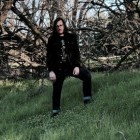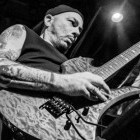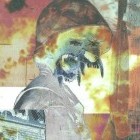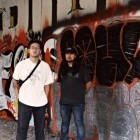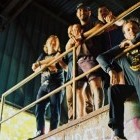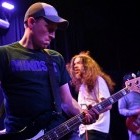
A native Manhattanite, and the son of Argentinian parents, Martin Bisi has been an integral part of the underground New York City music scene since the late '70s. Through his engineering and production work, Bisi has helped shape the sonic blueprints of punk, funk, noise, rap, and various other musical styles. His discography features such fellow heavyweights as Sonic Youth, Herbie Hancock, Swans, and Material, perfectly illustrating Bisi's diverse tastes.
Decades since he first touched a mixing desk, Bisi is still producing some of his best work at his BC Studio in Brooklyn. He's also found time to release solo material, with 2014's Ex Nihilo being his latest full-length project. Bisi recently released a music video for "The Mermaid Queen," a track from Ex Nihilo, and announced a slew of US and European tour dates.
Since I've been a longtime admirer of his work, I was honored to chat with Bisi about some of his career highlights.
Your mother was a classical pianist, and your father also played. I always wished my parents loved music as much as I did, that way they would've understood me better. What was your relationship with them like as a kid?
My mom was a serious overachiever in music. She was forced, presumably, to practice piano all day as a child and be tutored instead of going to school. Her aunt was a serious opera singer who performed with Caruso, and her mom (my gramma) managed the singer and was in the biz. And my mom, showing very early talent in piano, was expected to follow suit and, similarly, was very pushy with me about excellence in the arts. Anything short of all the way was mediocre in her mind. Other than this, she was very distant, and actually since I showed seemingly no artistic talent as a child, I was left feeling like a massive disappointment. I was even sent to the Museum of Modern Art for classes, and the best I could come up with was tagging on the subways in the '70s, though my mom had died by that point.
My dad was a jovial person who played tango piano on the side, which was frowned upon by my mom. I only saw him play once, and he was quickly shut down, but I was transfixed, much more impressed by that one moment than my mom's classical playing. Both of my parents tried to cultivate my contemporary taste, since I was pretty uninterested in the classics. They got me John McLaughlin's Extrapolation and the Grateful Dead's Anthem of the Sun along with my first turntable. That was pretty smart, actually. I kinda dug those records.
I'm also from New York City, but I was born in 1975. I obviously didn't get to experience what the music movement was like in the late '70s. Did you find that the different scenes (disco, funk, rock, punk, etc.) of that time meshed well, or was it a very segregated kind of thing?
Not segregated at all, at least in Manhattan. That was a clear meeting point of all the tribes, whether from the Bronx or somewhat "bridge and tunnel," as with the Ramones or Blondie network who were more likely to be natives of Queens or Brooklyn. The nature of some of the nightclubs facilitated that, like the amazing Danceteria, with four floors with all different programming, and Tier 3 in Tribeca with three floors. So, all these disparate genres got equal time, and I don't even remember the cover charge at either place. I guess it was very affordable, even though it was totally in this clubbing mode.
SEE ALSO: The Graffiti and Hardcore Connection
Were you playing in any bands at the time?
Any hope of being in a band would have been via my drumming, and I was unusually funky and polyrhythmic. I couldn't really play rock or thrashy beats, nor was I interested in being involved in rock, until Sonic Youth came to the studio and that was my introduction to doing something interesting in rock. So, I didn't see any place for me as a drummer in the early years.
At the end of that decade, you opened a studio in Brooklyn which was initially called OAO Studios, and eventually became BC Studio. Now, that's decades before the borough became the musician hotbed it is now. What was it about Brooklyn that drew you in back then?
Coming to Gowanus [a neighborhood in Brooklyn] was really because I found the right space, and that's where I could find it. I even timed the subway ride to Manhattan, so I knew late-night I could get to Danceteria and CBGB's without a huge hassle. Brooklyn was the only place you could find large and affordable industrial space, and that's what me and the Material collective wanted. Already Soho and Tribeca were priced out. I didn't even fathom that the area could draw the arts at any point. [Bill] Laswell was joking one day in 1980 that one day we'd see Tim Wright, bass player from DNA, stumbling around Park Slope in the daylight. I thought, "No way," but he was right. Moving to Gowanus, and specifically within a block of the toxic Gowanus Canal, was one of those very lucky choices that have made it possible to maintain the studio. I almost settled in Williamsburg, but if that would have happened, then I probably would not have lasted this long.
One of the albums you produced and engineered early in your discography that I love is Material's Memory Serves, from 1981. Bill Laswell's bass tone on that record is ace. Since Bill was your partner in the studio, and an engineer in his own right, did you guys ever clash on ideas during those Material sessions?
Me and Laswell never clashed in the early years. We were right on the same page. It wasn't until he started coming back, in the late '80s after our initial split, that I realized he had become very dub and low-end oriented, and I was more high-end oriented as in guitar and rock. Even though that seems like feathers of a cap, it made me think he wasn't a good rock producer, and it made a big difference with mixing, in terms of focus, and was maybe a terminal difference as far as collaborating
Michael Beinhorn was in Material during that era. He went on to become a very successful producer working with such artists as Hole and Soundgarden.
Laswell and Michael (he abhors being called "Beinhorn") did a lot of private planning before sessions. They were really an entity, but then somehow Laswell was the one who spoke and seemed to drive it. I would try to decipher what were the different directions being synthesized, 'cause I do better if I understand the deliberations happening. But it wasn't 'til years later that I realized that Michael was his own person in that area. Laswell had a bit of a dominating personality. I felt that I had more of a "soul connection" to Laswell than he and Michael, who seemed to have a very professional focus, but I can't tell for sure.
The history of Herbie Hancock's "Rockit" has been well documented throughout the years, but I wanted to ask you about Herbie's manager at the time, Tony Meilandt. Was he the person who brought Herbie into your orbit in the first place? Here was a musician who had already won multiple Grammys, and worked on seminal jazz albums with Miles Davis. I find it fascinating that he found a powerful muse in early hip-hop and the no wave scene. I mean, it's his biggest song to this day.
Meilandt had a big interest in Laswell generally, and eventually went on to manage him as well. So, he facilitated the connection between Laswell and Hancock. But there was also a chance encounter between the two, where Hancock told Bill he wanted to do a track like Malcolm McLaren's hip-hop inspired "Buffalo Gals." McLaren had gone to the Bronx a couple years before (with Michael Holman from the famous TV Pilot Graffiti Rock), and had seen the big Zulu Nation parties. So, Laswell saw that as an opportunity, since we saw and knew a lot of those same people at the big Friday nights at The Roxy, where seemingly the whole Bronx scene came downtown, with break dancers, etc. "Rockit" began Laswell's path of resuscitating the careers of fading stars.
I wouldn't say Hancock was too enthralled with what he saw in NYC when Laswell took him around. Bill took him to The Roxy, and Hancock wasn't so into it. And if he took a shining to no wave, it wasn't the no wave of Lydia Lunch, Glenn Branca, and DNA. There were jazz and dance hybrids that were also considered no wave, like Konk, so maybe he was exposed to that.
Jean Karakos' Celluloid was an influential NYC-based label you did a lot of work with during the '80s. Tell me about your relationship with Jean, and the label, back then.
Karakos was a little out of my league at the time. I didn't feel very comfortable, nor was I very into dealing with business people. There was almost a tacit arrangement between me and Laswell that that was his domain, in part due to my younger age. And he enjoyed those types of (mostly) male personalities, these alpha mavericks who were kind of slippery but driven to change the world. And really, these felt like his role models. [Entertainment impresario] Giorgio Gomelsky and [Island Records founder] Chris Blackwell, and even [CBGB's owner] Hilly Kristal were also in this category. I wasn't comfortable with the idea of success that dealing with big business people suggested.
I was kind of in denial about the intersection of doing something important in music and it being successful, and any time it felt like it was going there, I looked the other way. One day me and Bill were discussing our difficulty paying the meager rent at the studio. Bill insisted this could never be a worry. So, overnight he got Karakos to start paying our rent. I wasn't too worried that I'd be doing Karakos' bidding for a year. I was kind of into being part of that. I understood Karakos was the mentor and patron we needed. The relationship came to an end when he and Laswell wanted to move the studio into Manhattan, and with Karakos saying I needed to learn more about "gadgets." I spoke in French with him, so he would say "le gadgette."
In 1985 you worked on Whitney Houston's debut performance when she sang "Memories" on Material's One Down album. How did she become involved with that project, and did she nail her parts down easily?
Whitney's vocals were the one thing on One Down that I didn't record. That had to be done at a high-end studio in Manhattan, because there was a strong connection between Whitney's mom, Cissy Houston, and the label president. That's how it came about.
I had no idea.
She came recommended and it was political. None of us had heard of her previously, and basically we couldn't bring her to a D.I.Y. situation in a mostly abandoned factory in Gowanus. She did the song in two takes. She was very well prepared.
SEE ALSO: 2014 interview with Ron Nevision (Producer, Engineer: Led Zeppelin, Heart, KISS).
1985 also saw you producing on Bad Moon Rising, Sonic Youth's sophomore album. They were obviously coming from the no wave thing in the way they approached their instruments and arrangements, especially on a song like "Society is a Hole." Since they had such a left-of-center approach, was getting the guitars down—tonally speaking—an issue on those sessions?
I don't recall getting the guitar tones being difficult at all. I think when you have very interesting sounds, if you capture them decently, they're gonna be good. The challenges emerged in the mixing, how to put all that together, whether there would be additional effects, editing, and what the focus would be—rhythm vs. bass, guitars, vocals, etc. That's consistent with how I work now. A lot of it comes together in the mix, even without a lot of elements. It's where I ask a lot of the biggest questions.
Of all of the records you worked on in the '80s, which are a few that you think people overlooked?
- V-Effect, Stop Those Songs: that one was produced by Fred Frith.
- The Smurfs, Smurf for What it's Worth: that was the first rap song/single I can think of with distorted rock guitar pick slides—"metal" as we called it—years before Run-D.M.C. broke through that wall.
- Don King, One-Two Punch: featuring Mark Cunningham (Mars) and Arto Lindsay.
- The Ordinaires, The Ordinaires: it was a big band (10+) with noise roots and orchestral instruments doing odd pop.
- Of a Mesh, Broken: Proto-dark wave with Samara Lubelski, who later went on to play in Chelsea Light Moving.
Let's get into your solo records. You've been releasing material since the late '80s. Do you think there's some kind of common thread that weaves all of your work together in any way?
They all really are supposed to have an emotional impact, one way or the other I'd say that's catharsis. "Drink Your Wine" [from 2013's Son of a Gun EP] was supposed to have as much sheer joy as possible. I always found joy to be the most challenging emotion to conjure, and if you can truly achieve that, you really got something. So, if you include some of the fright I was trying to induce in the long outro in Ex Nihilo—which I titled, only in my mind, "The Holocaust"—and the evocative spirituality of "All Will be Won," it's clear that emotion has always been my bottom line.
You recently released a video for "The Mermaid Queen," a track from your 2014 album, Ex Nihilo. It's interesting, but the first time I listened to it, I found it to be a bit jarring in its delivery since there's almost like two different songs going on at the same time in parts. But after I listened to it a few times, it made more sense to my ears, like some kind of adjustment period.
There's a stage in most of my songwriting that is subconscious. I always start with guitar. Usually I ask whether there might be some words that come to me, 'cause only then do I feel I have a guitar part I can go forward with. So, I put myself on the spot and open my mouth. In the same way your subconscious decides what to dream about, the words come that will come, guided by the guitar and reflecting some inner fantasy or anxiety. Usually if it feels like there's a deeper essence there, I'll go with it, then figure out what more I can say about it, and how. That was the case with "The Mermaid Queen." Somehow my mind wrapped up in people and scenes, strangers and friends from the Mermaid Parade in Coney Island. I didn't exactly intend to sing on this topic, and I was actually a little shocked that once again I had the theme of a myth with women in it. I had an album and a song, Sirens of the Apocalypse [2007], that related to the Greek myth of the Sirens.
I like tricking the mind, the ear, into going as far as possible, and hopefully I don't often overshoot. So, what might seem to some as a creative dysfunction, of overdoing, and trying to put in too many ideas, and then articulating it, has been an important part of my work with many artists for decades—whether it's the John Zorn game pieces with 15 people playing at once, or overachievers and over-experimenters such as Sonic Youth, Swans, and J.G. Thirlwell. You can even see it in "Rockit." What hip-hop song at the time would have scratching featured all the way through, with live [African] Yoruba "batá" drumming and a Led Zeppelin guitar stab? What feels like two songs going at once in "The Mermaid Queen" is my not being satisfied with it being a simple rocker, that it just demanded to be taken as far as possible. I believe you couldn't add one single more thing into that soup. I'm not surprised it feels like two songs at once. The opera singer was the final afterthought, though of course it's the crowning cherry of the concept.
What can people expect from your upcoming tour dates in the US and Europe? Will you be culling material from your entire discography, or are you centering the setlist on the more recent output?
It will be recent material, with improvised hints of future material that is still being hashed out. The current live material feels pretty informed by my experiences in the early '80s, musically and psychologically, and that might say something about these times. There's not much of the vibe from my '90s and early/mid-'00s work.
SEE ALSO: Punks on Film
If you had to pick one record that you've worked on that best represents your body of work, what would it be and why?
Of my solo work, it would be Ex Nihilo, clearly. I actually intended it to be legacy-defining, in going back to my emerging days as an artist and recording studio person—as though I was still that person—of when I was 19, concerned with spirituality, living in an urban dystopia, angry, in awe of the apocalypse the world was seemingly facing then as now, with hints of primal sexuality. So, I hate to say it, but if I were to disappear soon, I wanted to leave people with Ex Nihilo (from nothing). As for other people's work, maybe Material's Seven Souls, with William Burroughs. It has the spirituality, existentialism, gravitas, fear, beauty—with Foday Musa Suso's kora playing [West African instrument] and rhythm, that are the essence of my artistic concerns.
As for sonics, you might have to look at the two Sonic Youth albums, Bad Moon Rising and Evol. "Shadow of a Doubt," from Evol, has one of my staples, the chaotic bridge mid-song freakout, where all hell breaks loose after a peaceful, calming setup. Both me and the band were shocked that that bridge took us a whole day to arrange, with all the chaotic voices, but that foreshadowed what that kind of work entailed. "Death Valley '69" has the aggressively swirling guitars that Lydia Lunch, who sings on the song, dubbed "the hurricane," and that no wave wall of sound and angst that I conjure periodically. I've realized lately that I have a bit of a [Chilean director Alejandro] Jodorowsky-esque macabre carnival side, you hear it in my "Goth Chick '98," and the Dresden Dolls' eponymous record should get a mention in that regard.
***
Martin Bisi's Ex Nihilo album is available on vinyl via Labelship, and digitally on iTunes. Head to MartinBisi.com for all of his upcoming tour dates.

